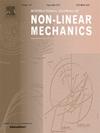A general framework for symplectic geometric integration for stochastically excited Hamiltonian systems on manifolds
IF 2.8
3区 工程技术
Q2 MECHANICS
International Journal of Non-Linear Mechanics
Pub Date : 2024-12-26
DOI:10.1016/j.ijnonlinmec.2024.105001
引用次数: 0
Abstract
This work introduces a new integration scheme in the field of Stochastic Geometric Integration on Manifolds, dedicated to precise modeling of real-world dynamic phenomena characterized by inherent randomness. Conventional numerical techniques often encounter difficulties when confronted with uncertainty and the preservation of manifold geometry, consequently leading to inaccuracies. In response to these challenges, the method proposed considers geometric precision, stochastic dynamics, and symplecticity all-together. Drawing inspiration from methods based on Lie groups, this work formulates a framework that can adapt to stochastic systems, aligning itself with the principles of geometric stochastic differential equations. By incorporating higher-order geometric integration schemes possessing inherent symplectic properties, the study achieves accurate solutions that simultaneously retain intricate system geometry, maintain symplecticity, and accommodate inherent randomness. The method maintains its general flavor by virtue of a completely intrinsic formulation which can be adopted to broad class of manifolds rather than a specific one. Through numerous representative benchmarks, the study substantiates the effectiveness of the proposed scheme. The results demonstrate a significant enhancement in the numerical scheme’s performance, owing to its utilization of the inherent symplectic nature.
求助全文
约1分钟内获得全文
求助全文
来源期刊
CiteScore
5.50
自引率
9.40%
发文量
192
审稿时长
67 days
期刊介绍:
The International Journal of Non-Linear Mechanics provides a specific medium for dissemination of high-quality research results in the various areas of theoretical, applied, and experimental mechanics of solids, fluids, structures, and systems where the phenomena are inherently non-linear.
The journal brings together original results in non-linear problems in elasticity, plasticity, dynamics, vibrations, wave-propagation, rheology, fluid-structure interaction systems, stability, biomechanics, micro- and nano-structures, materials, metamaterials, and in other diverse areas.
Papers may be analytical, computational or experimental in nature. Treatments of non-linear differential equations wherein solutions and properties of solutions are emphasized but physical aspects are not adequately relevant, will not be considered for possible publication. Both deterministic and stochastic approaches are fostered. Contributions pertaining to both established and emerging fields are encouraged.

 求助内容:
求助内容: 应助结果提醒方式:
应助结果提醒方式:


